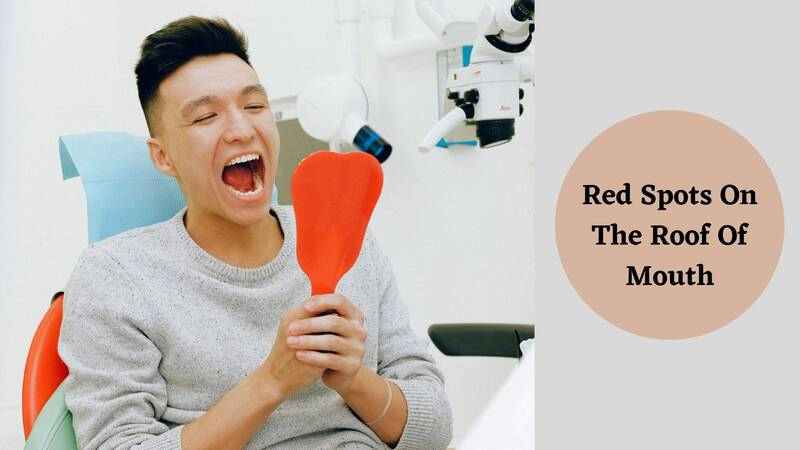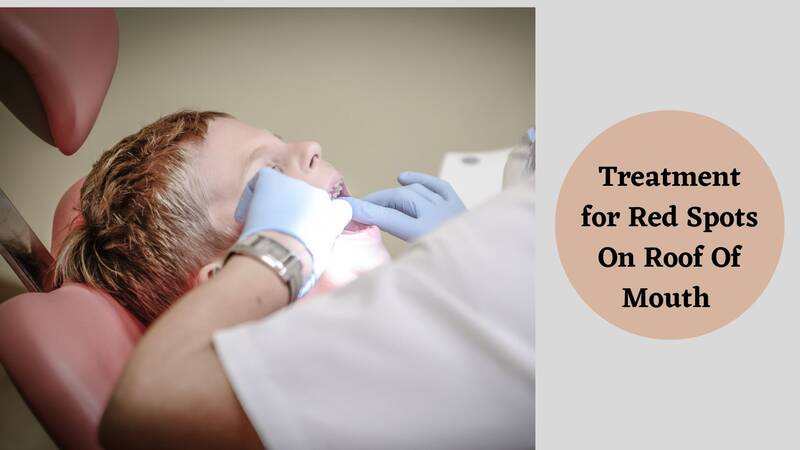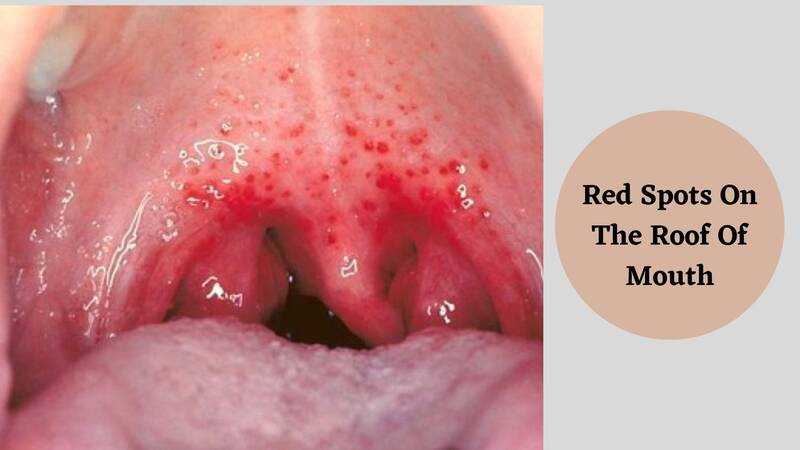There are several people who are experiencing red bumps or spots on the roof of the mouth at some point.
Irritation from foods, mouth or throat infection, and dentures are the common causes of Red Spots On Roof Of Mouth,
Red spots that are present on the roof of your mouth can irritate you, but they are mainly harmless and should be going away by themselves.
People can easily visit a doctor for any rising concerns or do not know what causes the spots as it can be a sign of something that is more serious.
In our post today, we are going to dive into the factors causing red spots on the roof of your mouth, identifying the causes and their probable treatment.
Contents
Causes For The Red Spots On Roof Of Mouth

The red spots in your mouth may have various different causes, several of which are inflammatory in their nature.
Inflammation occurs due to systemic diseases as well as environmental triggers that cause irritation on the mucosal lining of your mouth.
There are various causes that can be grouped easily into the following categories:
Strep throat infection
Strep throat is generally an infection affecting your tonsils and throat.
A streptococcus is a group of bacteria that causes this infection.
Small red spots known as petechiae that happen on the roof of your mouth are noted to be the common symptom of strep throat infection.
The following are the other symptoms of strep throat:
- high temperature
- pain during swallowing
- red and inflamed tonsils
- inflated lymph nodes
They should visit a doctor or an ear, nose, and throat specialist if a person is suspected of having strep throat.
Treatment here includes a course of antibiotics, resting, and drinking a sufficient amount of fluid.
Physical injury
One of the common causes of a red spot or a sore on the roof of your mouth creates a sudden injury that appears as a burn or a cut.
It happens due to drinking something that is very hot or from eating food causing bruising from chewing or biting.
The following are the other conditions leading to physical injury as well as bruising:
- dentures that fail to fit in a proper way
- edge for a broken tooth
- broken crowns or bridges, as well as uneven dental fillings
- Allergic or sensitive to certain ingredients in a few mouthwash or toothpaste.
It is recommended to wait for about 2 weeks allowing the damaged tissue to heal.
They would recommend checking with a dentist to diagnose the condition.
Oral thrush
Oral thrush is a yeast infection that is caused by the fungus Candida which is also considered candidiasis.
Everyone has Candida present within their digestive tract or on their skin, but under the specific condition, the fungi multiply, causing an infection.
A person can consult with their doctor or dentist about these symptoms if they suspect that they have oral thrush.
According to a healthcare professional, it can be diagnosed by examining the mouth.
They may even ask for an oral swab of the throat and mouth for checking under the microscope in a few cases.
Mouth ulcers
The sore that occurs within the mouth is a mouth ulcer. It causes discomfort making it tough to eat or drink.
Mouth sores tend to become clear, but they will persist, bleeding, or become an infection in a few cases.
The following are the common attributes contributing to mouth ulcers:
- dehydration
- Poor oral hygiene
- Excessive alcohol consumption
- Tobacco use
- Lack of dietary protein
- Vitamin deficiencies
- Certain medications or treatments, including radiation therapy
Mouth sores can be alleviated by eating soft, neutral foods and drinking lukewarm water.
Foods that are abrasive, salty, or acidic should be avoided until the sores have healed since they might irritate the affected area and cause discomfort.
Hand, foot, and mouth disease (HFMD)
HFMD is a viral infection that affects the hands, feet, and mouth.
It immensely affects kids under the age of five, but it can also affect older children and adults.
The initial symptom of HFMD indicates a very high fever.
After a couple of days, painful sores develop inside your mouth.
It is mainly noted by the professionals are herpangina.
These sores are mainly smaller in size, with red spots appearing at the rear end of the mouth. The spots turn into blisters, thereby leading to pain.
HFMD may lead to a rash on the palms of your hand along with the soles of your feet, at times appearing on your knees, elbows, and intimate regions.
There are several mild cases where individuals have HFMD with no probable symptoms.
For HMFD, there is no probable treatment, although people can make use of OTC or over-the-counter medications to reduce fever and pain.
The oral sprays and mouthwashes can help in relieving mouth pain.
Oral herpes
Herpes is a viral ailment caused by the herpes simplex virus (HSV).
This virus causes open sores in or around the mouth, sometimes known as cold sores or fever blisters.
Cold sores usually form on the corners of the lips, but they can also appear inside the mouth, particularly on the roof.
They usually seem as white, open sores, but they can sometimes appear as red spots, especially when they’re first forming and healing.
HSV is carried by more than half of all Americans aged 14 to 49.
Cold sores appear with the reduced retention of the immune system in people, especially during cold weather or some other sickness or infections.
Cold sores mainly get clear on their own within a couple of weeks.
People should avoid close physical contact with others to avoid personal sharing items, including toothbrushes, razors, towels, and lip balms, to prevent the transmission of the virus.
Canker sores
The smaller ulcers are developing on the roof or within the mouth, causing canker sores.
The canker sores appear like ulcers with yellow, grey, and white centers along with a red and flat border. They start with red spots or bumps that grow in size for a few days.
The main cause of the canker sores remains unknown, but there are a few risk factors, including:
- genetics
- fatigue
- emotional stress
- certain foods causing irritation
Canker sores are not contagious and heal in about 7-10 days, unlike cold sores.
People can relieve the discomfort by using OTC topical creams, antimicrobial mouth rinses, and gels at this time.
Erythroplakia
Erythroplakia is a red spot or a spot commonly noticed on the floor or side of the mouth.
Doctors do not completely understand its causes, but it is found common for people to use alcohol and tobacco in excess.
The following are the main aspects of erythroplakia:
- smooth, velvety lesions that appear soft to the touch
- lesions surrounded by a well-defined border
- a painful, burning sensation
- a metallic taste in the mouth
It is noted from the studies that erythroplakia is often the early sign of mouth cancer.
People should visit their doctor if they suspect having erythroplakia.
Doctors may recommend removing the tissue with the help of laser treatment or surgery to prevent the development of cancerous tissues.
Read– Pacifier Teeth
Treatment for Red Spots On the Roof Of the Mouth

Because there are so many reasons for red spots in the mouth, your treatment will be tailored to the origin of your symptoms.
Your doctor may advise you to do one of the following things, depending on the cause:
Antibiotics and antifungals: Your doctor will prescribe antibiotics if you have a bacterial illness.
They may prescribe an antifungal if you have a fungal infection.
Antibiotics do not work against viruses. Thus you will not be given one if you have one.
Anti-inflammatory drugs: If you have an autoimmune condition, you may be prescribed steroids and anti-inflammatory medications to help you manage your symptoms.
Diet counseling: Your physician will suggest starting a dedicated nutrition program to help with the symptoms since diet is a vital aspect in the pathogenesis of this condition in the mouth.
Read– How Do Braces Move Teeth?
FAQs
Below we share some FAQs related to the Query “Red Spots On Roof Of Mouth”
1〉 Will anything there to try out to avoid developing red spots in my mouth?
Because many of the reasons for red spots in the mouth are contagious, it’s critical to keep oneself safe from germs by practicing good hygiene, such as hand washing.
Put your hands in your mouth as little as possible, especially after handling doorknobs or socializing with ill people.
In addition, eating a healthy diet and avoiding tobacco and alcohol can help to prevent red spots in the mouth.
2〉 Do red spots in the mouth considered life-threatening or dangerous?
Red spots in the mouth are generally irritating and unsettling rather than harmful or life-threatening.
A red patch in your mouth, on the other hand, could be an indication of a malignant process, so don’t dismiss your symptoms.
It’s essential to keep note of the symptoms because many underlying illnesses necessitate further investigation and therapy.
3〉 How long will my mouth’s red streaks last?
The length of your symptoms will be determined by the underlying cause.
For instance, bacterial explanations for red spots in the mouth usually go away once the underlying bacteria are resolved, whereas autoimmune reasons for red spots in the mouth can last a lifetime.
4〉 Are red spots in the mouth a short-term or long-term problem?
Red spots in the mouth can become chronic in some situations, particularly those connected with autoimmune diseases like inflammatory bowel disease.
Chronic habits like nicotine and alcohol can cause red spots to persist and become chronic, although bacterial infections are more severe.
5〉 Is it possible for red spots in my mouth to travel to other regions of my body?
Depending on the source, red spots in the mouth might spread to other parts of the body.
Infectious reasons ranging from bacteria to fungus, for example, can create spots not just in the mouth but also in the genitalia and under the armpits.
6〉 How do you deal with mouth redness?
Mouth sores can be alleviated by eating soft, bland foods and drinking lukewarm water.
Foods that are abrasive, salty, or acidic should be avoided until the sores have healed since they might irritate the affected area and cause discomfort.
7〉 What do the red specks in your mouth indicate?
Petechiae are little red pimples on the roof of your mouth that are a common side effect of a strep throat infection.
Small vessels in the roof of your mouth leak causing these lumps, which are frequently caused by serious infections.
8〉 What’s the deal with the dots in my mouth?
Acne around the mouth can be caused by repetitive pressure on the skin near the mouth, such as from using a cell phone or playing a musical instrument on a regular basis.
9〉 Is it possible for acid reflux to generate red patches in the mouth?
Yes, sore patches or sores in the mouth can be caused by frequent or severe acid reflux.
Gum disease, tongue disease, and palate disease are all possibilities.
10〉 What is the appearance of oral leukoplakia?
Leukoplakia occurs on the inside surfaces of your mouth as thick, white spots.
It can be caused by a variety of factors, including repetitive damage or irritation. It could potentially be an indication of oral cancer or precancerous alterations.
Read– How to Clean Invisalign?
Wrapping Up
- There are several conditions leading to the Red Spots On Roof Of Mouth, a few of which are harmless and resolve on their own.
- A few of the red spots indicate an oral infection. People should consult with their doctor if the symptoms last for a long time, about a week, which is quite painful.
- Several treatments depend on the underlying cause of the condition, including mouth rinses, antibiotics, oral gels, and balms.
Read– Does Tooth Extraction Hurt?
- Things to Invest in for the Easter Season in 2024 - March 29, 2024
- Why Experience Matters: Finding An Established Dental Implants Provider - March 29, 2024
- Commense Return Policy in 2024 (Full Detailed) - March 4, 2024
